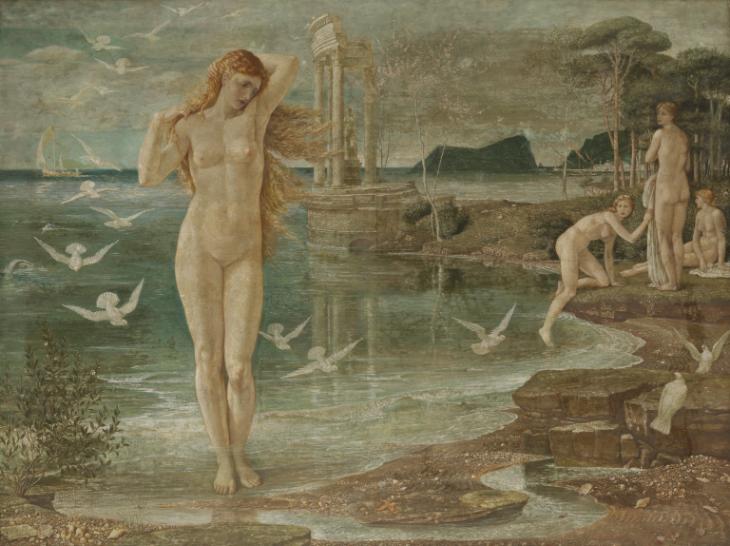
The painters of the Symbolist movement were particularly keen upon classical mythological scenes and made good use of the many gods, goddesses and other beings. Aphrodite and her sisters appear quite frequently in pictures. The Birth of Venus is a common scene, sometimes presented in slavish imitation of Botticelli, as is the case with Walter Crane’s canvas of 1877, The Renaissance of Venus. Doves flutter past, myrtle (a plant sacred to Aphrodite) sprouts on the shore and the naked goddess tries to control her billowing hair, whilst looking down demurely to one side. Venus is an attractive young woman, but with quite a muscular frame. We might suppose that Crane wished to represent the intersex aspect of the goddess, but in fact the story goes that his wife objected to him working from naked female models, so he painted instead from an Italian called Alessandro di Marco, a young man popular with many London artists. Allegedly Lord Leighton spotted Alessandro’s physique adapted to become Aphrodite when the picture was first exhibited at the Grosvenor Gallery. Far less inspired is the image of Venus’ Mirror included below, in which Crane’s goddess seems no more than a Victorian lady admiring herself- though admittedly she may be suffering something of a wardrobe malfunction.
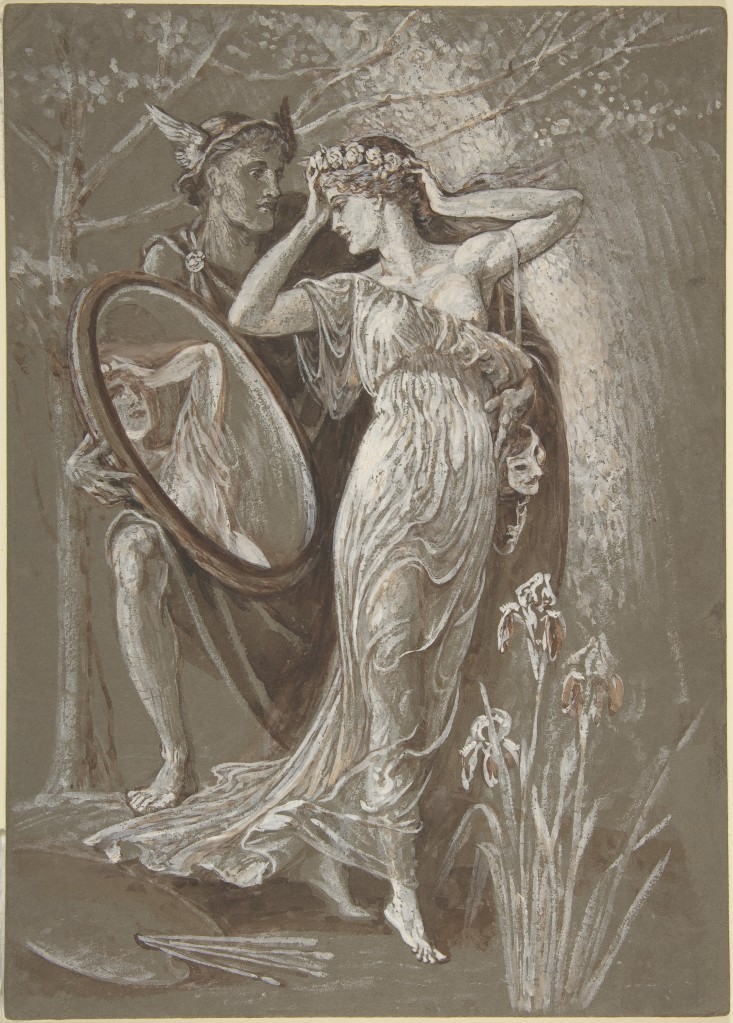
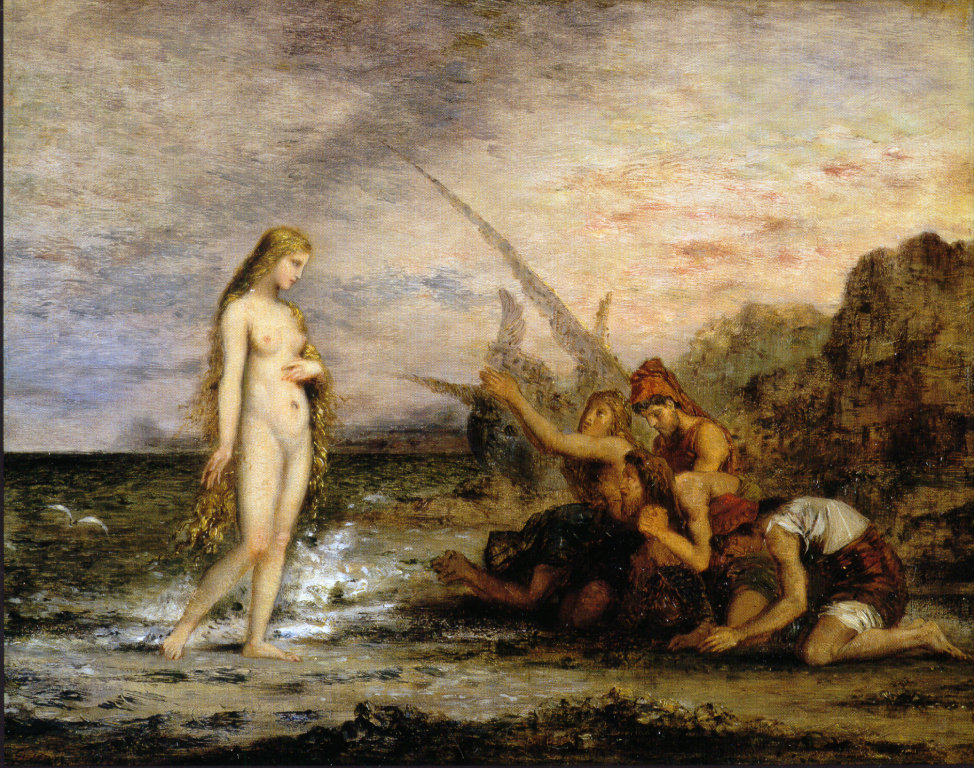
French painter Gustave Moreau created some comparably conventional pictures: in his Birth of Venus (Venus Appearing to Fishermen) a similar long-haired, slender and youthful blonde emerges from the waves to receive the fishermen’s obeisance, whilst The Birth of Venus/ Naissance de Venus is an even more slavish copy of Botticelli and others. More original is his Venus Rising from the Sea (1866), in which the goddess appears, arms outstretched to support her voluminous locks, whilst attendants offer her pearls and coral. Moreau’s vision of the goddess is always rather pallid and insipid, though, lacking Aphrodite’s energy and power.
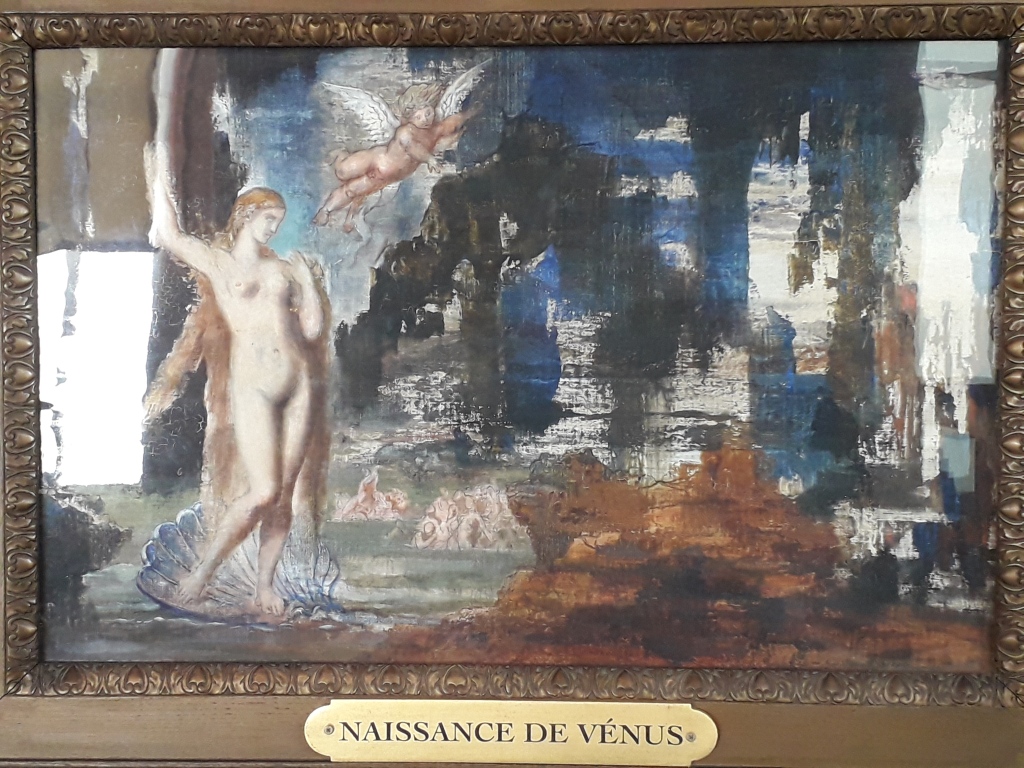
In contrast, Odilon Redon offers several sensually glowing visions of the same divine birth. The bright pink body of the goddess is revealed within a rosy heart of a shell, as if emerging from a womb (1866 and two from 1912). In a third canvas, dating from 1910, she sits at ease in a deep red shell, watching the breaking waves. In a fourth scene, also from 1912, she floats ashore in a giant nautilus shell. Redon’s images, with their flesh pink tones and the emphasis upon the oyster-like shell, are expressly sensual. One of the ancient symbols of the goddess was the scallop shell, a reference to her birth from the shell as we see in Botticelli and in Moreau’s Naissance, but it also signified the female genitalia and emphasised the goddess’ sexual nature. Indeed, in the play Rudens by Roman author Plautus, two girls who are devoted to the goddess are described as conchas, shells: this term seems to have a double meaning.
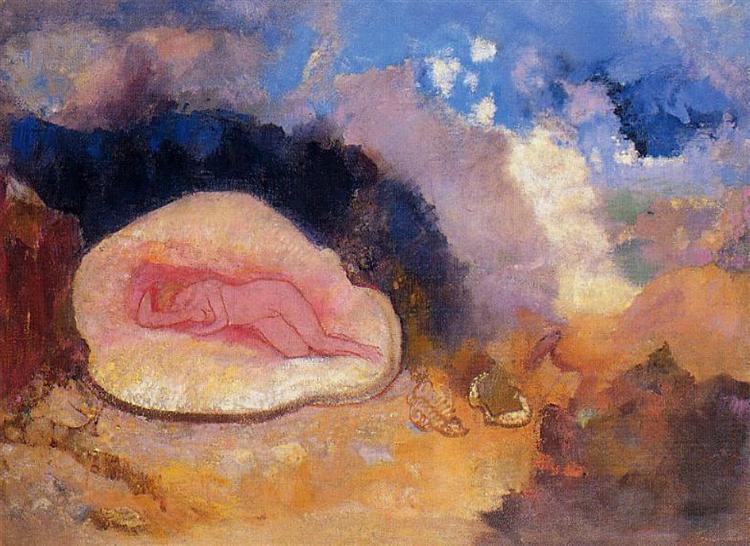
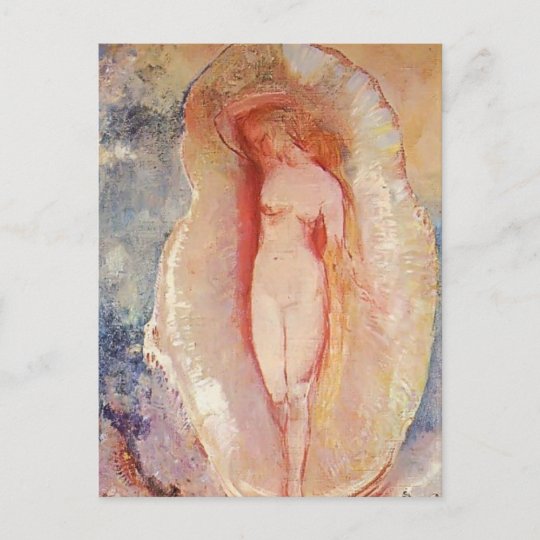
Swiss Arnold Böcklin is known for his classical scenes, in which he regularly portrayed mythical beings such as sirens, nymphs, centaurs and fauns. He also tackled Venus’ birth several times. His Venus Anadyomene (born of the waves), painted in 1872, is carried across the sea by a monstrous dolphin (another animal closely linked to the goddess in her marine aspects), whilst little cupids with butterfly wings flutter above her head, holding gauzy draperies around her. A Birth of Venus from 1869 rehearses the same scene, but with only a couple of cupids and the goddess’ robes merging into what resembles a waterspout arising from the waves. Another such picture, also called the Green Venus, portrays the goddess walking on water.
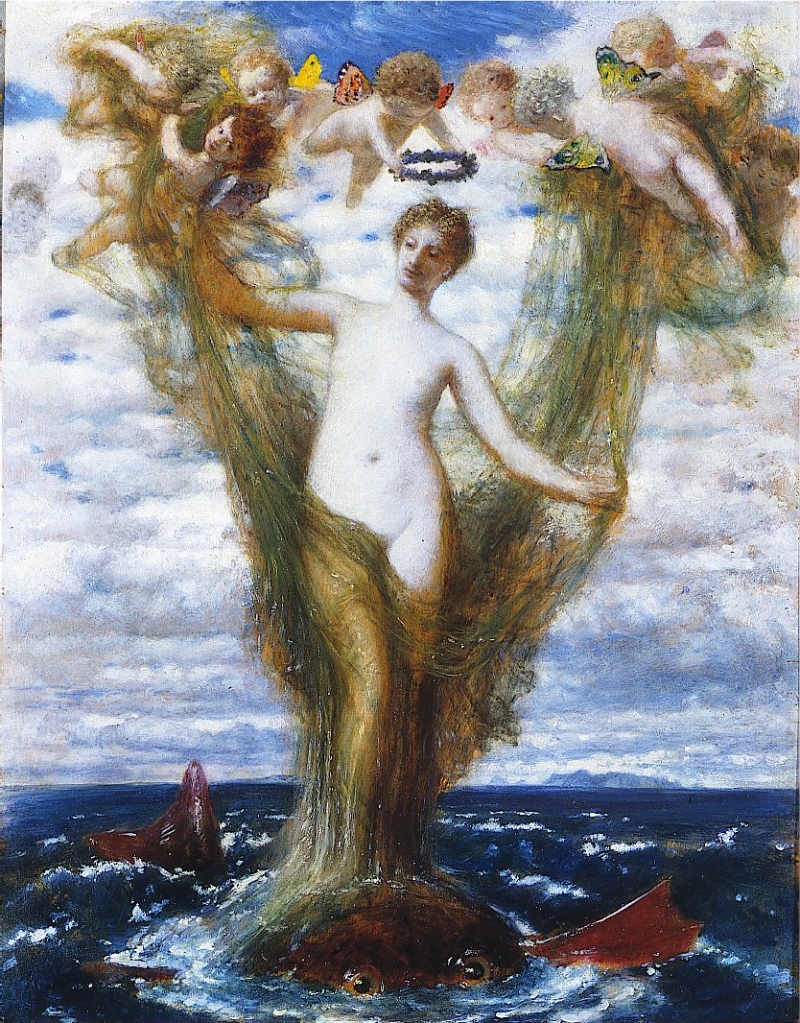
Nearly all of Böcklin’s goddesses seem to be the same staid-looking Germanic matron, who is largely devoid of sexual frisson. This is especially the case with his triptych Venus Genitrix (the mother of the (Roman) people ) of 1895. This version of the goddess attracted official worship under the Caesars in Rome in order to promote maternal qualities and, in addition, to underline Julian family claims to descent from her. Böcklin’s Venus is a respectable wife- who plays a triangle (?)- and is seen with her husband and her children (although the bare bottomed Eros/ Cupid is- admittedly- somewhat at odds with this overall tone. I assume he’s there to bring the two young lovers together). If so, Böcklin’s Venus Dispatching Love of 1901 depicts a slightly earlier episode from this love story. In this image, a rather more voluptuous and wanton Venus is seen reclining beneath a myrtle, sending her son to bring trouble in mortals’ lives.

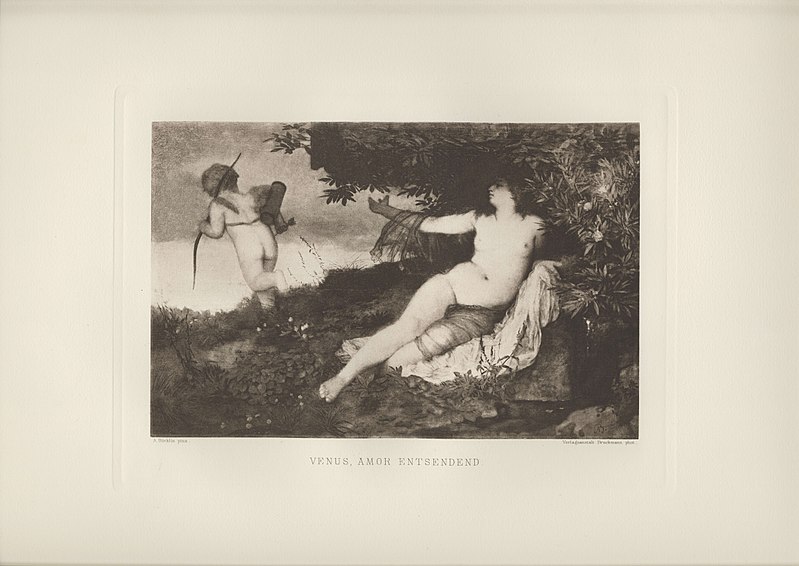
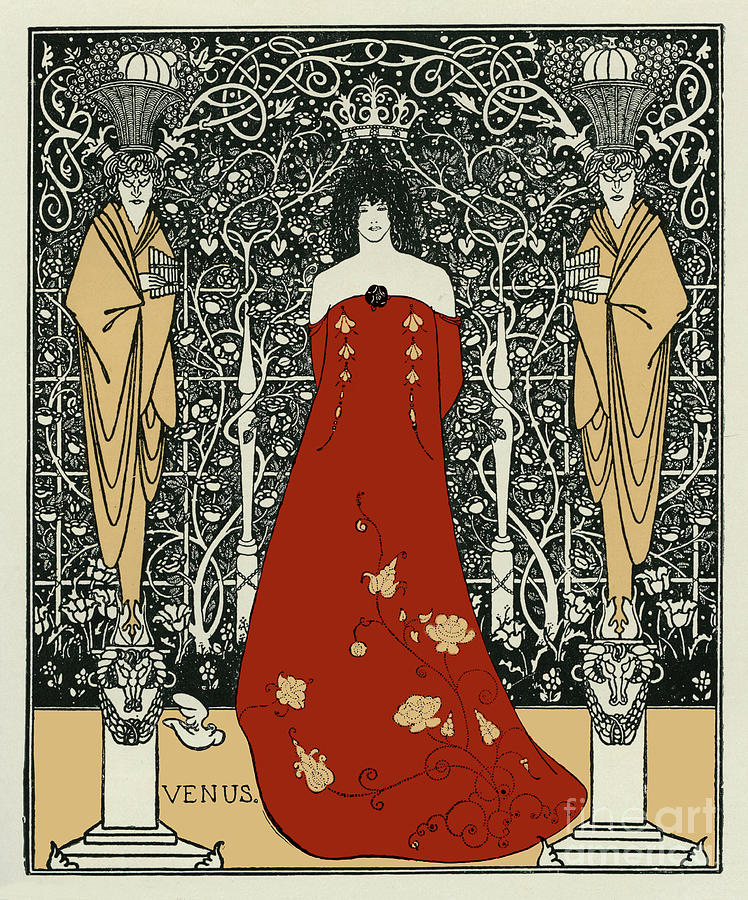
Sexuality was never far from the work of Aubrey Beardsley (1872-98). His Venus Between Two Terminal Gods (1895) depicts the goddess wearing a long, off-the-shoulder dress, with dark, tousled hair. She faces the viewer impassively, sternly even, as a dove glides in front of her. The statues on either side hold pan-pipes and carry baskets overflowing with fruit on their heads. This is a respectable, slightly intimidating deity, whereas in Eros and Aphrodite, she is blatantly the harlot queen of physical love. We see her from behind, wearing only knee length stockings and reaching between her legs. Eros powders between her buttocks and thighs with a large soft brush, at the same time sporting a large erection; it appears as though they are both getting rather excited by the titivations. The indications of incest- and of a prostitute preparing herself for a client- are typical of Beardsley’s taste. Nonetheless, they are very much in the tradition of Bronzino and the mythology as well.
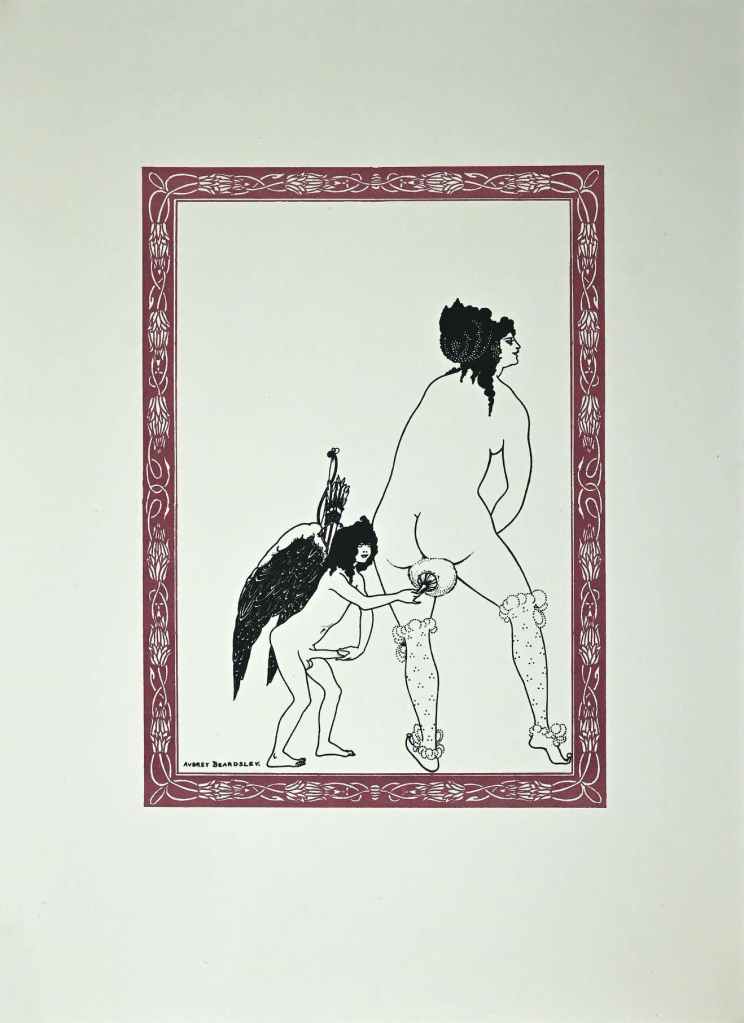
Symbolist style was adopted by society portraitist John Singer Sargent when he was asked to provide murals for Boston public library. His cycle, titled The Triumph of Religion, covers Egyptian and Assyrian religion as well Bible scenes portraying Judaism and Christianity. The work on the cylce, which is still to be found on the hallway of the third floor of the McKim Building, occupied Sargent between 1890 and 1919.
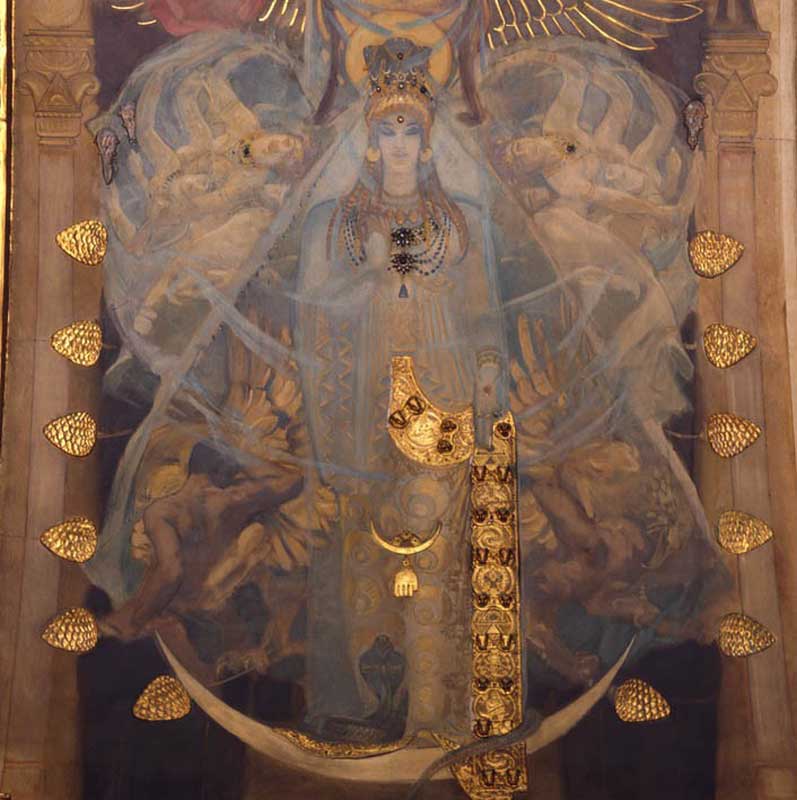
Amongst the pagan gods the artist portrayed is a striking Astarte, painted in 1895, who wears a blue robe and stands upon a crescent moon. She is encrusted with beads and gold ornamentation highly reminiscent of Gustav Klimt. Naked attendants surround her, their hands raised in worship. Her eyes are closed and her lips bear a beatific smile. She is serene and powerful, sparkling with light, and is arguably a great deal more attractive a figure than the rather worthy ‘Mysteries of the Rosary,’ ‘Dogma of Redemption,’ ‘Israelites Oppressed’ or ‘Prophets.’
